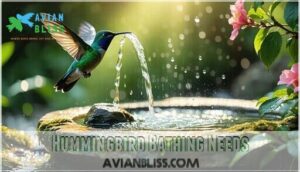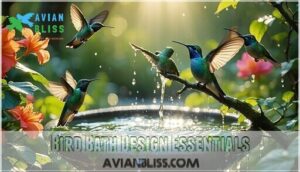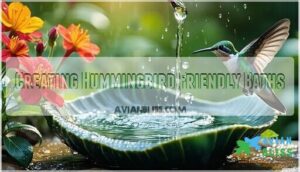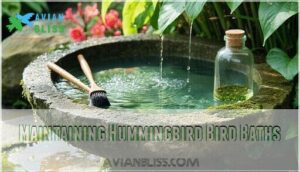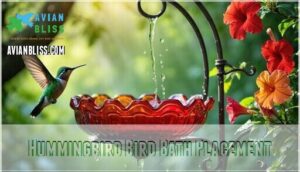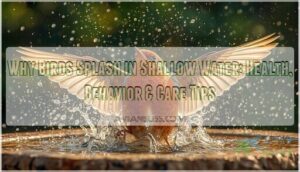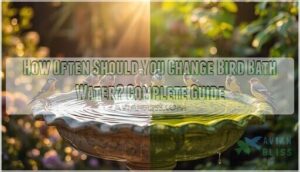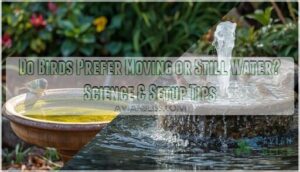This site is supported by our readers. We may earn a commission, at no cost to you, if you purchase through links.

Opt for a small basin or flat surface, no deeper than an inch—hummingbirds aren’t fans of deep water.
Incorporate features like fountains, misters, or drippers since they prefer moving water and tiny droplets to bathe and drink.
Add perches, textured surfaces, or smooth stones for stability and comfort.
Brightly colored designs mimic flowers and attract their attention.
Keep the bath elevated and clear of predators, with nearby shade or native plants for cover.
Curious about maintaining crystal-clear water and creating the ultimate hummingbird spa? Stay tuned!
Table Of Contents
- Key Takeaways
- Hummingbird Bathing Needs
- Bird Bath Design Essentials
- Creating Hummingbird Friendly Baths
- Maintaining Hummingbird Bird Baths
- Hummingbird Bird Bath Placement
- Frequently Asked Questions (FAQs)
- What is the best bird bath for hummingbirds?
- How deep should a hummingbird bird bath be?
- Where is the best place to put a hummingbird bath?
- What depth is ideal for a hummingbird bird bath?
- Do hummingbirds prefer moving water in a bird bath?
- How frequently should I clean a hummingbird bird bath?
- How do you set up a hummingbird bath?
- How often should a hummingbird bath be refilled?
- What materials last longest outdoors for bird baths?
- Can hummingbird baths attract other birds?
- Conclusion
Key Takeaways
- You’ll attract more hummingbirds with shallow water (1-1.5 inches deep) and moving water features like misters, drippers, or fountains that mimic their natural bathing preferences.
- Add textured surfaces, smooth stones, or small perches to your bird bath to provide stability and comfort for these tiny birds while they bathe and preen.
- Incorporate bright colors (especially red) in your bird bath design to attract hummingbirds, and place it near nectar-rich native plants for a complete habitat.
- Clean your hummingbird bird bath every 2-3 days and refill it daily to maintain water quality, prevent algae growth, and keep it safe from predators by placing it in an elevated, visible location.
Hummingbird Bathing Needs
Hummingbirds need safe, shallow water and are drawn to gentle sprays or misters for bathing.
These tiny birds rely on moving water features to help them clean their feathers and stay cool.
Moving Water Preferences
Hummingbirds love moving water, so a fountain with unique spray patterns or a DIY hummingbird mister is perfect.
A DIY hummingbird mister or unique fountain spray creates a mesmerizing water feature that delights and attracts these playful, tiny birds.
Gentle sprays mimic an invigorating waterfall, while mister attachments and dripper benefits keep things simple.
Moving water attracts them better than still pools, making a hummingbird bird bath with waterfall features the ultimate treat for these tiny feathered friends.
Shallow Water Requirements
When setting up a hummingbird bird bath, focus on safe depth and easy access.
Keep the basin depth under two inches—just right for a shallow bird bath where tiny birds can splash without risk.
Opt for materials that resist algae while ensuring cleaning ease.
A shallow bath designed with care helps your little visitors stay healthy and groomed effortlessly, which is crucial for their overall well-being in a shallow bird bath.
Natural Hydration Sources
A hummingbird’s hydration mostly comes from nature’s genius design. They sip flower nectar for energy while collecting dew droplets and plant moisture for a smooth refresh.
Natural streams and rainwater collection spots are their delight too. Consider enhancing your hummingbird garden with a moving water feature to mimic these natural sources.
- Enjoys dew consumption early mornings.
- Loves feeding off plant moisture after rainfall.
- Relies on flower nectar for hydration and nourishment.
These additions can also prevent mosquito breeding effectively by creating a moving water feature that mimics natural sources, supporting the birds’ need for smooth refresh.
Bird Bath Design Essentials
To design a perfect hummingbird bird bath, focus on shallow basins, gentle water movement, and stable perches. These features guarantee hummingbirds can bathe safely while mimicking their preferred natural habitats.
Fountain and Misters Features
Water that moves is irresistible! Add a solar fountain for efficiency and keep water fresh with a misting system design.
Play with fountain nozzle types or DIY fountain builds for unique sprays. Low water pressure effects are ideal for tiny birds.
A hummingbird water feature creates a playful oasis while doubling as a spot for grooming and hydration. Many prefer the convenience of solar powered fountains.
| Feature | Benefit | Details |
|---|---|---|
| Solar Fountain | Energy-efficient design | Works in direct sunlight |
| Moving Water | Attracts hummingbirds naturally | Mimics streams or rain |
| Misting System Design | Gentle spray for bathing | Perfect for a hummingbird bird bath |
| Fountain Nozzle Types | Variety of spray patterns | Enhances visual and bathing appeal |
Many prefer the convenience of solar powered fountains.
Shallow Basin Designs
For a perfect hummingbird bird bath design, focus on shallow basins. Aim for a safe bird bath depth of 1-2 inches—ideal for tiny feet.
Add gravel bottoms or well-placed stones to prevent slipping. Use durable basin materials like concrete for longevity.
Depth variations support splashing. DIY basins let you customize every detail, ensuring a personal touch and functional charm.
Perch and Textured Surfaces
A well-designed hummingbird bird bath needs sturdy perches and textured surfaces.
Use branching sticks or twiggy branches near the basin for perch stability, helping birds preen feathers comfortably.
Choose a textured basin to guarantee surface grip and reduce slipping, one option is to think about a basin with anti-slip paints for enhanced safety.
Perch materials, like slim sticks, mimic natural preening stations, offering both function and charm, and should be used to keep everything anchored for hummingbird safety.
Creating Hummingbird Friendly Baths
You can make your yard a hummingbird hot spot by offering safe, shallow water with attractive features like misters or fountains.
Adding bright colors and nearby native plants will make the space even more inviting for these tiny, lively visitors.
Bright Color Attractions
A hummingbird bird bath with bright colors, especially red, taps into color psychology to mimic flowers they love.
Floral patterns enhance the design’s appeal, drawing them closer. UV-resistant dyes guarantee color longevity, keeping your hummingbird garden vibrant.
Consider a red hummingbird feeder for added attraction. These features both boost hummingbird attraction and create a striking focal point in your yard, blending beauty and functionality.
Safe Placement Strategies
Thoughtful bird bath placement guarantees hummingbird safety and encourages visits.
- Avoid Pesticides: Keep baths away from treated areas.
- Reduce Reflections: Prevent windows nearby to avoid collisions.
- Prevent Freezing: Use heaters or store baths in winter.
- Secure Mounting: Stabilize baths to prevent tipping.
- Limit Access: Place baths high, safe from predators.
Good placement guarantees a thriving, peaceful oasis.
Native Plant Incorporations
Native plants like trumpet vine or bee-balm can transform your yard into a hummingbird haven.
Their nectar-rich blooms attract pollinators while supporting biodiversity. Focus on regional flora for a low-maintenance setup that enriches habitats naturally.
Consider adding a reliable water source to further attract birds. Pair these flowers with hummingbird feeders and decor to enhance habitat enrichment.
Strategically placed, they amplify both the beauty and function of your hummingbird garden.
Maintaining Hummingbird Bird Baths
Keeping your hummingbird bird bath clean and well-maintained guarantees it remains safe and appealing for these tiny visitors.
Regularly freshening the water, scrubbing the basin, and checking for potential hazards help create a healthy environment for them to enjoy, and by doing so, you ensure the bath stays safe.
Regular Cleaning Schedules
Keeping a hummingbird bird bath clean is essential for their health. Regular cleaning prevents algae buildup and bacteria.
Regular cleaning keeps bird baths safe, algae-free, and ensures hummingbirds always enjoy fresh water and a healthy splash zone.
Follow these steps:
- Use a vinegar solution for bird bath cleaning.
- Refill with fresh water every two days.
- Perform routine inspections for clogs or debris.
- Scrub surfaces gently to maintain hygiene.
- Winterize baths to avoid freezing damage.
Water Quality Monitoring
Clean water is key for hummingbird health.
Prevent algae by rinsing the bird bath with a vinegar solution during regular cleanings. Test water quality and refill frequently to guarantee fresh water.
Remove debris daily to maintain bird bath hygiene and sanitation. For ideal cleanliness, consider following ceramic bird bath maintenance tips.
A clean setup attracts hummingbirds while keeping them safe and happy. Keep it fresh, they’ll thank you!
Predator Proofing Techniques
Don’t just clean the water—guard it.
Protect your bath height and safety by placing bird baths away from dense shrubs where predators hide.
Boost bird bath predator protection with motion sensors or reflective surfaces to spook cats or snakes.
A key element is a hummingbird bath guard for safety.
Add thorny bushes near baths for natural shields, and consider cage designs that let hummingbirds in but keep threats out.
Hummingbird Bird Bath Placement
Placing your hummingbird bird bath in the right spot guarantees it’s both attractive and safe for these tiny visitors.
Choose a location with nearby food sources, plenty of sunlight, and some shelter from wind and predators, which are complete concepts for their well-being.
Proximity to Food Sources
Placing a hummingbird bath near nectar-rich flowers or feeders maximizes visits.
Hummingbirds save energy with shorter flights, especially when food and water are close. Space baths about 3 feet from feeders to avoid competing resources.
Use this table for key tips:
| Factor | Optimal Distance | Why It Matters |
|---|---|---|
| Nectar Proximity | 2-4 feet | Encourages frequent visits |
| Feeder Distance | 3 feet | Reduces territorial behavior |
| Plant Placement | Nearby flowering plants | Mimics natural hummingbird habitat |
Sunlight and Wind Considerations
Sunlight powers solar panels for moving water but balance is key.
Direct sunlight boosts function, yet shade prevents overheating and evaporation.
Use windbreak strategies like shrubs to reduce water loss and keep the area calm.
On overcast days, check water levels often as fountains may slow.
Shaded bathing spots create a cool oasis while harnessing sunlight smartly.
Safety From Predators and Hazards
Keeping hummingbirds safe means thinking ahead. Elevated baths create distance from curious cats, offering better bird bath safety.
Open visibility helps you spot predators, while thorny shrubs add thorns protection. Netting options can shield baths from bold intruders.
Always place your bath away from thick vegetation where predators may lurk. Thoughtful bath placement is key for hummingbird and bird bath predator protection.
Frequently Asked Questions (FAQs)
What is the best bird bath for hummingbirds?
Think of water as an irresistible magnet for hummingbirds.
The best bird bath features shallow basins, moving water like misters or fountains, and bright colors (like red) to attract them.
Add stones for safety and comfort.
How deep should a hummingbird bird bath be?
A hummingbird bath should be no deeper than 1 to 5 inches.
They’re tiny birds, so shallow water keeps them safe and comfortable while they bathe, splash, and enjoy a rejuvenating dip.
Where is the best place to put a hummingbird bath?
Place a hummingbird bath near flowers or feeders for easy access.
Make certain it’s shaded to prevent overheating, but not fully hidden.
Hummingbirds like open spots with nearby perches, so they can bathe and rest.
What depth is ideal for a hummingbird bird bath?
Aim for a bath depth of about 1 to 5 inches.
Shallow water keeps tiny hummingbirds safe while letting them splash comfortably.
Adding smooth stones can help create perches and prevent accidental slips in deeper spots.
Do hummingbirds prefer moving water in a bird bath?
Yes, they absolutely love moving water.
Gentle sprays, drippers, or misters mimic natural streams they adore.
It’s like a spa day – they splash, preen, and cool off while enjoying the soothing flow.
How frequently should I clean a hummingbird bird bath?
Clean it every two to three days to guarantee fresh water and prevent algae.
Think of it like a spa day—hummingbirds won’t bathe in dirty water, so keep it fresh and inviting!
How do you set up a hummingbird bath?
Start with a shallow basin and add stones for safety.
Use a mister or fountain to mimic moving water, then place perches nearby.
Bright colors like red help attract hummingbirds, making your setup irresistible.
How often should a hummingbird bath be refilled?
You’ll want to refill a hummingbird bath daily, especially on hot or windy days.
Fresh water keeps it inviting and safe for bathing, while preventing algae growth or debris buildup that might scare them away.
What materials last longest outdoors for bird baths?
Stone and ceramic bird baths are like the tortoises of outdoor materials—they’re slow to wear out.
They resist weathering, stay stable, and don’t crack easily.
Opt for cast stone or glazed ceramic for durability.
Can hummingbird baths attract other birds?
Yes, hummingbird baths can attract other small birds, especially those drawn to shallow water or gentle sprays.
Wrens, finches, and chickadees may join the fun, making your garden a lively, feathered oasis.
Conclusion
Transforming your yard into a hummingbird haven is easier than it seems.
By focusing on a practical hummingbird bird bath design with shallow water, moving features like misters or fountains, and safe, elevated placement, you’ll attract these tiny wonders while ensuring their safety.
Add bright colors, textured perches, and nearby native plants for an inviting, natural appeal.
Maintain clean water and predator-free zones for their comfort.
Your thoughtful setup will create the ultimate, hummingbird-approved backyard retreat.
- https://www.dropbox.com/s/b5ohzoeqdx13u8p/B-034%20Hummingbird%20Birdbath_spec%20sheet.pdf?dl=0
- http://mailto:info
- https://www.duncraft.com/index/page/static/subpage/returns_exchanges/
- https://www.audubon.org/news/hummingbirds-see-red
- https://www.facebook.com/plugins/live_chat/continue_as/?page_id=354808591621053&request_id=f45a3c32-e542-b985-49de-119e1dcdec7e

